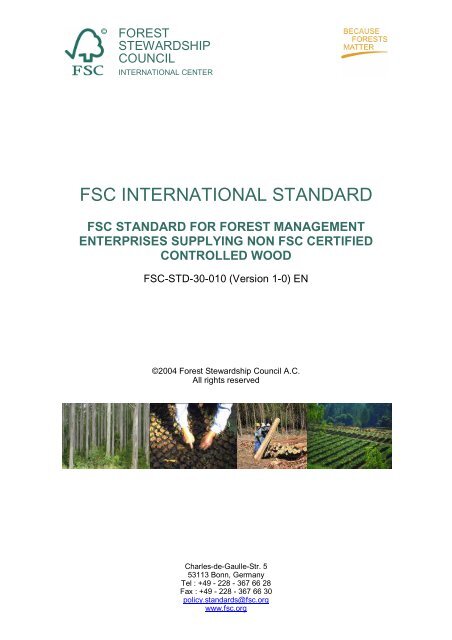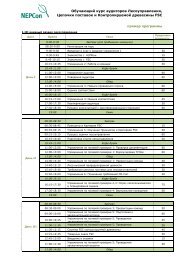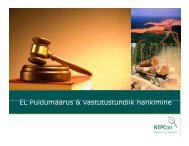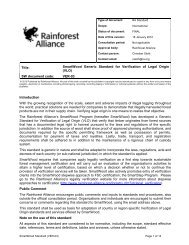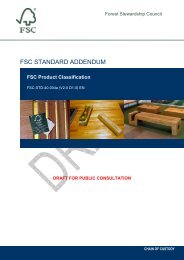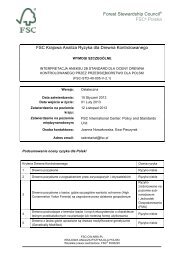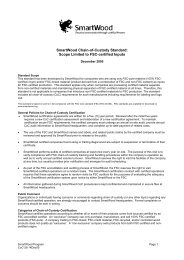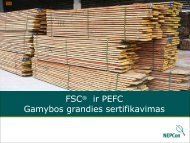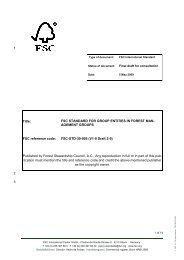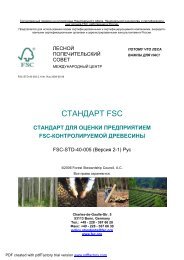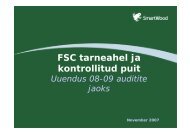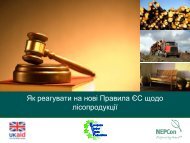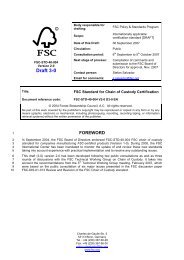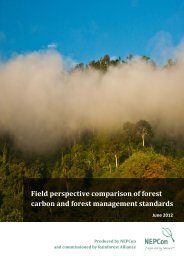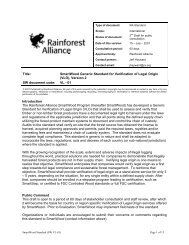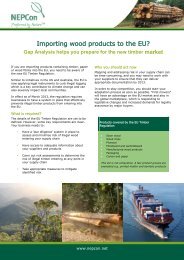FSC-STD-30-010 V2-0 - NEPCon
FSC-STD-30-010 V2-0 - NEPCon
FSC-STD-30-010 V2-0 - NEPCon
Create successful ePaper yourself
Turn your PDF publications into a flip-book with our unique Google optimized e-Paper software.
FOREST<br />
STEWARDSHIP<br />
COUNCIL<br />
INTERNATIONAL CENTER<br />
<strong>FSC</strong> INTERNATIONAL STANDARD<br />
<strong>FSC</strong> STANDARD FOR FOREST MANAGEMENT<br />
ENTERPRISES SUPPLYING NON <strong>FSC</strong> CERTIFIED<br />
CONTROLLED WOOD<br />
<strong>FSC</strong>-<strong>STD</strong>-<strong>30</strong>-<strong>010</strong> (Version 1-0) EN<br />
©2004 Forest Stewardship Council A.C.<br />
All rights reserved<br />
Charles-de-Gaulle-Str. 5<br />
53113 Bonn, Germany<br />
Tel : +49 - 228 - 367 66 28<br />
Fax : +49 - 228 - 367 66 <strong>30</strong><br />
policy.standards@fsc.org<br />
www.fsc.org
©2004 Forest Stewardship Council A.C. All rights reserved.<br />
<strong>FSC</strong> STANDARD FOR FOREST MANAGEMENT ENTERPRISES<br />
SUPPLYING NON <strong>FSC</strong> CERTIFIED CONTROLLED WOOD<br />
<strong>FSC</strong>-<strong>STD</strong>-<strong>30</strong>-<strong>010</strong> (V1-0) EN<br />
Approved September 2004<br />
34 th meeting of the <strong>FSC</strong> Board of Directors<br />
©2004 Forest Stewardship Council, A.C. All rights reserved. No part of this work covered by the<br />
publisher’s copyright may be reproduced or copied in any form or by any means (graphic, electronic<br />
or mechanical, including photocopying, recording, recording taping, or information retrieval systems)<br />
without the written permission of the publisher.<br />
The Forest Stewardship Council (<strong>FSC</strong>) is an independent, not for profit, non-government<br />
organisation based in Bonn, Germany.<br />
The mission of the Forest Stewardship Council is to support environmentally appropriate,<br />
socially beneficial, and economically viable management of the world's forests.<br />
<strong>FSC</strong> develops, supports and promotes international, national and regional standards in line with<br />
its mission; evaluates, accredits and monitors certification bodies which verify the use of <strong>FSC</strong><br />
standards; provides training and information; and promotes the use of products that carry the<br />
<strong>FSC</strong> logo.<br />
<strong>FSC</strong>-<strong>STD</strong>-<strong>30</strong>-<strong>010</strong> V1-0 EN<br />
<strong>FSC</strong> STANDARD FOR FOREST MANAGEMENT ENTERPRISES SUPPLYING NON <strong>FSC</strong> CERTIFIED<br />
CONTROLLED WOOD<br />
– 2 of 12 –
©2004 Forest Stewardship Council A.C. All rights reserved.<br />
Foreword<br />
This standard specifies the basic requirements applicable at the forest management unit<br />
(FMU) level to demonstrate to a company or third party certification body that wood supplied<br />
is controlled. It has been developed to allow forest management enterprises supplying wood<br />
as controlled to demonstrate that they do not supply wood that has been harvested from<br />
categories outlined in <strong>FSC</strong>-<strong>STD</strong>-<strong>30</strong>-<strong>010</strong> <strong>FSC</strong> requirements for forest managers for controlled<br />
wood, i.e wood from areas where traditional or civil rights are violated; wood from forests<br />
where high conservation values are threatened; wood harvested from genetically modified<br />
(GM) trees; wood that has been harvested illegally or wood harvested from areas which<br />
have been converted from natural forest to plantations or non-forest uses.<br />
Compliance with this standard provides a consistent, international basis for business-tobusiness<br />
communications about the sourcing of wood products. It provides the basis for<br />
forest management enterprises to supply controlled wood to companies that wish to<br />
demonstrate compliance with <strong>FSC</strong>-<strong>STD</strong>-40-004 <strong>FSC</strong> chain of custody standard for<br />
companies supplying and manufacturing <strong>FSC</strong>-certified products and <strong>FSC</strong>-<strong>STD</strong>-40-005 <strong>FSC</strong><br />
standard for non-<strong>FSC</strong> certified controlled wood.<br />
The requirements outlined in this standard allow companies to demonstrate compliance with<br />
selected components of legality (legal harvesting) and is not intended to demonstrate the<br />
implementation of all national and international laws.<br />
The standard outlines streamlined requirements for small and low intensity forest<br />
management enterprises (SLIMFs).<br />
Please send any comments or suggestions regarding this standard to:<br />
<strong>FSC</strong> International Center<br />
– Policy and Standards Unit –<br />
Charles-de-Gaulle Str. 5<br />
53113 Bonn, Germany<br />
Phone: +49-228 / 367-6628<br />
Fax: +49-228 / 367-66<strong>30</strong><br />
E-Mail: policy.standards@fsc.org<br />
<strong>FSC</strong>-<strong>STD</strong>-<strong>30</strong>-<strong>010</strong> V1-0 EN<br />
<strong>FSC</strong> STANDARD FOR FOREST MANAGEMENT ENTERPRISES SUPPLYING NON <strong>FSC</strong> CERTIFIED<br />
CONTROLLED WOOD<br />
– 3 of 12 –
©2004 Forest Stewardship Council A.C. All rights reserved.<br />
Contents<br />
A<br />
B<br />
C<br />
D<br />
Scope<br />
Standard effective date<br />
References<br />
Terms and definitions<br />
1 Scope of standard<br />
2 Controlled wood categories<br />
3 Wood harvested from areas where civil and traditional rights are violated<br />
4 Wood harvested from forest having high conservation values which are<br />
threatened<br />
5 Wood harvested from genetically modified (GM) trees<br />
6 Illegally harvested wood<br />
7 Wood harvested from areas which have been converted from natural forest to<br />
plantations or non-forest uses<br />
8 Stakeholder consultation<br />
Annexes<br />
Annex 1<br />
Glossary of terms<br />
A Scope<br />
This standard applies to non <strong>FSC</strong>-certified forest management enterprises who are<br />
supplying ‘controlled wood’. The standard is relevant to forest managers or forest<br />
management companies (herein referred to as forest management enterprises) and is<br />
applied at the forest management unit level for wood or wood fibre being supplied as<br />
controlled. The standard can be applied for one or all of the categories of wood a) -e) in<br />
Section 2.1 below.<br />
B Standard effective date<br />
This standard is effective from 1 st October 2004.<br />
Forest management enterprises wishing to supply non <strong>FSC</strong>-certified wood from high-risk<br />
forest areas as controlled wood will be required to meet this standard by 1 st January 2006.<br />
Forest management enterprises wishing to supply non <strong>FSC</strong>-certified wood from high-risk<br />
forest areas as controlled wood will be required to meet this standard from 1 st January 2007.<br />
C References<br />
<strong>FSC</strong>-<strong>STD</strong>-01-001 <strong>FSC</strong> Principles and Criteria of Forest Stewardship<br />
<strong>FSC</strong>-<strong>STD</strong>-40-004 <strong>FSC</strong> chain of custody standard for companies supplying and<br />
manufacturing <strong>FSC</strong>-certified products<br />
<strong>FSC</strong>-<strong>STD</strong>-<strong>30</strong>-<strong>010</strong> V1-0 EN<br />
<strong>FSC</strong> STANDARD FOR FOREST MANAGEMENT ENTERPRISES SUPPLYING NON <strong>FSC</strong> CERTIFIED<br />
CONTROLLED WOOD<br />
– 4 of 12 –
©2004 Forest Stewardship Council A.C. All rights reserved.<br />
<strong>FSC</strong>-<strong>STD</strong>-40-005 <strong>FSC</strong> standard for non <strong>FSC</strong>-certified controlled wood<br />
<strong>FSC</strong>-<strong>STD</strong>-01-003 SLIMF eligibility criteria<br />
D Terms and definitions<br />
Terms and definitions are provided in <strong>FSC</strong>-<strong>STD</strong>-01-002 <strong>FSC</strong> glossary of terms. Key<br />
definitions relating to this standard are underlined and are provided in Annex 1 and are<br />
underlined in the text.<br />
<strong>FSC</strong>-<strong>STD</strong>-<strong>30</strong>-<strong>010</strong> V1-0 EN<br />
<strong>FSC</strong> STANDARD FOR FOREST MANAGEMENT ENTERPRISES SUPPLYING NON <strong>FSC</strong> CERTIFIED<br />
CONTROLLED WOOD<br />
– 5 of 12 –
©2004 Forest Stewardship Council A.C. All rights reserved.<br />
1. Scope of standard<br />
1.1. This standard applies to non <strong>FSC</strong>-certified forest management enterprises and<br />
applies to wood sources being supplied as controlled. The standard is applied at the<br />
forest management unit level.<br />
2. Controlled sourced wood categories<br />
2.1. The forest management enterprise shall implement a programme to ensure that<br />
wood supplied as controlled is not from the following categories:<br />
a) forest areas where traditional or civil rights are violated by forest management<br />
activities (see Section 3 below);<br />
b) forest management units having high conservation values which are threatened<br />
(see Section 4 below);<br />
c) genetically modified (GM) trees (see Section 5 below);<br />
d) forest management units which have been harvested illegally (see Section 6<br />
below);<br />
e) natural forest that has been converted to plantations or non-forest use (see<br />
Section 7 below).<br />
3. Wood harvested from areas where civil and traditional rights are violated<br />
3.1. The forest management enterprise shall not supply as controlled, wood harvested<br />
from forest management units where there are conflicts relating to long term tenure<br />
or use rights to the land and forest resources by traditional or indigenous peoples<br />
groups and/or civil society groups which are of substantial magnitude; which involve<br />
a significant number of interests and for which a resolution process has not been<br />
agreed by the main parties to the dispute.<br />
3.2. The forest management enterprise shall make available on request documented<br />
evidence to demonstrate compliance with Section 3.1 above. This shall include but<br />
is not restricted to:<br />
a) documentation 1 showing identification of all local communities, traditional and<br />
indigenous peoples in the forest management unit and adjacent area;<br />
b) documentation showing the forest management enterprises’ ownership or legal<br />
right to harvest;<br />
c) documentation 2 recording traditional rights as identified by the communities and<br />
peoples groups identified in a) above;<br />
d) documented evidence 3 of consultation with local communities, traditional and<br />
indigenous peoples groups identified in a) above;<br />
e) documented evidence of the process by which any disputes are being resolved,<br />
which has the broad support of the parties to the dispute, and which outlines an<br />
agreed interim process for addressing the dispute and for the management of<br />
the forest area concerned.<br />
1 E.g. maps<br />
2 E.g. maps<br />
3 E.g. minutes of meetings<br />
<strong>FSC</strong>-<strong>STD</strong>-<strong>30</strong>-<strong>010</strong> V1-0 EN<br />
<strong>FSC</strong> STANDARD FOR FOREST MANAGEMENT ENTERPRISES SUPPLYING NON <strong>FSC</strong> CERTIFIED<br />
CONTROLLED WOOD<br />
– 6 of 12 –
©2004 Forest Stewardship Council A.C. All rights reserved.<br />
3.3. Small and Low Intensity Managed Forest (SLIMF) 4 enterprises are required to<br />
demonstrate compliance with only Sections 3.2 a) b) and e) above.<br />
4. Wood harvested from forest areas where high conservation values are<br />
threatened by forest management activities<br />
4.1. The forest management enterprise shall not supply as controlled, wood which has<br />
been harvested from non <strong>FSC</strong>-certified forest management units where forest<br />
management activity has the potential to cause irreversible effects on any of the<br />
high conservation values present.<br />
4.2. The forest management enterprise shall keep records of and make available on<br />
request documented evidence to demonstrate compliance with Section 4.1 above.<br />
Documented evidence shall include but is not restricted to:<br />
a) a documented assessment that identifies high conservation values and confirms<br />
the absence of threat to the biological, environmental, social and cultural high<br />
conservation values from forest management activity in the forest management<br />
unit;<br />
b) documented evidence 5 of consultation with stakeholders, including NGOs and<br />
parties that are involved with or have an interest in the forest area with respect of<br />
social or environmental aspects to confirm the findings of the assessment;<br />
c) documented evidence of consultation with representatives and members of<br />
communities and indigenous peoples living in or adjacent to the forest<br />
management unit, to confirm the findings of the assessment.<br />
4.3. If the forest enterprise is unsure whether a forest management unit has high<br />
conservation values present, then the precautionary approach shall be adopted and<br />
no wood shall be supplied until the presence of high conservation values has been<br />
assessed and appropriate management can be planned accordingly.<br />
4.4. In countries where there is a national definition of high conservation value forests<br />
(HCVF) as part of an <strong>FSC</strong> accredited or draft <strong>FSC</strong> national or sub-national standard,<br />
then this shall be used as the basis of the assessment specified in Section 4.2 a)<br />
above 6 .<br />
5. Wood harvested from genetically modified (GM) trees<br />
5.1. The forest management enterprises operating in plantations shall not supply as<br />
controlled, wood harvested from GM trees 7 .<br />
4 <strong>FSC</strong>-<strong>STD</strong>-01-003 Eligibility criteria for Small and Low Intensity Managed Forests (SLIMFs)<br />
5 For example minutes of meetings, letters of invitation, photographs<br />
6<br />
<strong>FSC</strong> national and regional standards can be obtained from the <strong>FSC</strong> national contact person. Contact details of<br />
national contact persons are available on www.fsc.org<br />
7 Note, this provision does not exclude traditional tree-breeding programmes.<br />
<strong>FSC</strong>-<strong>STD</strong>-<strong>30</strong>-<strong>010</strong> V1-0 EN<br />
<strong>FSC</strong> STANDARD FOR FOREST MANAGEMENT ENTERPRISES SUPPLYING NON <strong>FSC</strong> CERTIFIED<br />
CONTROLLED WOOD<br />
– 7 of 12 –
©2004 Forest Stewardship Council A.C. All rights reserved.<br />
5.2. The forest management enterprise shall keep records of and make available on<br />
request documented evidence to demonstrate compliance with Section 5.1 above.<br />
Documented evidence shall include but is not restricted to:<br />
a) documentation from national regulatory bodies confirming the locations and<br />
species of GM tree trials within the forest area;<br />
b) a statement signed by the senior executive that the forest management<br />
enterprise does not supply wood from GM trees.<br />
6. Illegally harvested wood<br />
6.1. The forest management enterprise shall not supply as controlled, wood which has<br />
been harvested in violation of national laws, including the acquisition of the<br />
harvesting rights and the harvesting methods used.<br />
6.2. The forest management enterprise shall keep records of and make available on<br />
request documented evidence to demonstrate compliance with Section 6.1 above.<br />
Documented evidence shall include but is not restricted to:<br />
a) concession license and/or harvesting permit (approved by appropriate<br />
government authority);<br />
b) maps and/or documents showing the location of harvesting within the harvesting<br />
license or permit area;<br />
c) a forest management plan for the forest management unit; maps; documents<br />
showing harvesting volumes and protected areas;<br />
d) an up-to-date register of all statutes, guidelines and regulations;<br />
e) sales contracts showing volumes sold;<br />
f) evidence of payment of royalties;<br />
g) an up to date list of tree species in the FMU that are listed in Appendices of the<br />
Convention on International Trade in Endangered Species of Wild Fauna and<br />
Flora (CITES) and relevant permits for their harvest and trade.<br />
6.3. The company shall ensure that the correct procedures were used to gain permits and<br />
licences and species harvested are classified correctly.<br />
7. Wood harvested from areas which have been converted from natural forest to<br />
plantations or non-forest uses<br />
7.1. The forest management enterprise shall not supply as controlled wood which has<br />
resulted from the conversion of natural forest to plantations or non-forest uses,<br />
except as permitted by Section 7.3 below.<br />
<strong>FSC</strong>-<strong>STD</strong>-<strong>30</strong>-<strong>010</strong> V1-0 EN<br />
<strong>FSC</strong> STANDARD FOR FOREST MANAGEMENT ENTERPRISES SUPPLYING NON <strong>FSC</strong> CERTIFIED<br />
CONTROLLED WOOD<br />
– 8 of 12 –
©2004 Forest Stewardship Council A.C. All rights reserved.<br />
7.2. The forest management enterprise shall shall keep records of and make available on<br />
request documented evidence to demonstrate compliance with Section 7.1 above.<br />
Documented evidence shall include but is not restricted to:<br />
a) maps and/or documents showing the location of harvesting within the harvesting<br />
license or permit area;<br />
b) a forest management plan for the forest management unit.<br />
7.3. Community forest areas where conversion is part of a community land use plan<br />
endorsed through a participatory process and which is < 5 % of the forest area, may<br />
supply wood which has been converted from natural forest to non-forest uses as<br />
controlled.<br />
7.4. The forest management enterprise shall make available on request documented<br />
evidence to demonstrate compliance with Section 7.3 above. Documented evidence<br />
shall include but is not restricted to:<br />
a) land use plan covering conversion of natural forest to non-forest use;<br />
b) documented evidence of consultation with representatives and members of<br />
communities endorsing the land-use planning.<br />
8. Stakeholder consultation<br />
8.1. The stakeholder consultation referred to in Sections 3.2 d); 4.2 b) and c); 7.4 b) shall<br />
ensure at least the following:<br />
a) key stakeholders (including potentially marginalized groups e.g. women) have<br />
been identified and invited to participate in the consultation with sufficient prior<br />
notice;<br />
b) the consultation process is open and transparent;<br />
c) stakeholders have access to necessary information to ensure effective<br />
participation in the consultation process.<br />
d) a process for recording, evaluating and addressing stakeholders’ concerns.<br />
<strong>FSC</strong>-<strong>STD</strong>-<strong>30</strong>-<strong>010</strong> V1-0 EN<br />
<strong>FSC</strong> STANDARD FOR FOREST MANAGEMENT ENTERPRISES SUPPLYING NON <strong>FSC</strong> CERTIFIED<br />
CONTROLLED WOOD<br />
– 9 of 12 –
©2004 Forest Stewardship Council A.C. All rights reserved.<br />
Annex 1: Glossary of terms<br />
Broad support. Agreement characterised by a wide and strong majority in favour of a<br />
proposal<br />
Civil rights. Right or rights belonging to a person by reason of citizenship<br />
Civil Rights Violations. Infringement of the right or rights belonging to a person by reason<br />
of citizenship<br />
Controlled wood. Wood or wood fibre which is identified by a company for exclusion of the<br />
wood categories outlined in <strong>FSC</strong>-<strong>STD</strong>-<strong>30</strong>-<strong>010</strong> <strong>FSC</strong> requirements for forest managers for<br />
controlled wood<br />
Customary rights: Rights which result from a long series of habitual or customary actions,<br />
constantly repeated, which have, by such repetition and by uninterrupted acquiescence,<br />
acquired the force of a law within a geographical or sociological unit (<strong>FSC</strong> Principles and<br />
Criteria)<br />
District. Area, county, locality<br />
Forest management enterprise. Company or operation responsible for forest management<br />
Genetically modified organism (GMO). Biological organisms which have been induced by<br />
various means to consist of genetic structural changes (<strong>FSC</strong> Principles and Criteria).<br />
Genetically modified (GM) tree. GMO derived from a tree species 8 .<br />
High Conservation Value Forests. High Conservation Value Forests are those that<br />
possess one or more of the following attributes: a) forest areas containing globally, regionally<br />
or nationally significant concentrations of biodiversity values (e.g. endemism, endangered<br />
species, refugia); and/or large landscape level forests, contained within, or containing the<br />
management unit, where viable populations of most if not all naturally occurring species exist<br />
in natural patterns of distribution and abundance b) forest areas that are in or contain rare,<br />
threatened or endangered ecosystems c) forest areas that provide basic services of nature<br />
in critical situations (e.g. watershed protection, erosion control) d) forest areas fundamental<br />
to meeting basic needs of local communities (e.g. subsistence, health) and/or critical to local<br />
communities’ traditional cultural identity (areas of cultural, ecological, economic or religious<br />
significance identified in cooperation with such local communities) (<strong>FSC</strong> Principles and<br />
Criteria).<br />
High Conservation Values. The attributes specified above as indicators of High<br />
Conservation Value Forest.<br />
High-risk forest area. Forest areas having a high risk of supplying wood from the<br />
categories outlined in <strong>FSC</strong>-<strong>STD</strong>-<strong>30</strong>-<strong>010</strong> <strong>FSC</strong> requirements for forest managers for controlled<br />
wood.<br />
8<br />
Clones, hybrids formed by natural processes, or the products of traditional tree breeding, selection, grafting,<br />
vegetative propagation or tissue culture are not GMOs, unless produced by GMO techniques (<strong>FSC</strong> POL-<strong>30</strong>-<br />
602).<br />
<strong>FSC</strong>-<strong>STD</strong>-<strong>30</strong>-<strong>010</strong> V1-0 EN<br />
<strong>FSC</strong> STANDARD FOR FOREST MANAGEMENT ENTERPRISES SUPPLYING NON <strong>FSC</strong> CERTIFIED<br />
CONTROLLED WOOD<br />
– 10 of 12 –
©2004 Forest Stewardship Council A.C. All rights reserved.<br />
Illegally harvested wood. Wood that has been harvested in violation of national laws<br />
including the acquisition of the harvesting rights from the rightful owner, the harvesting<br />
methods used, and payment of all relevant fees and royalties.<br />
Indigenous peoples. "The existing descendants of the peoples who inhabited the present<br />
territory of a country wholly or partially at the time when persons of a different culture or<br />
ethnic origin arrived there from other parts of the world, overcame them and, by conquest,<br />
settlement, or other means reduced them to a non-dominant or colonial situation; who today<br />
live more in conformity with their particular social, economic and cultural customs and<br />
traditions than with the institutions of the country of which they now form a part, under State<br />
structure which incorporates mainly the national, social and cultural characteristics of other<br />
segments of the population which are predominant." (Working definition adopted by the UN<br />
Working Group on Indigenous Peoples) (<strong>FSC</strong> Principles and Criteria).<br />
Key habitats. Habitats where red listed or endangered animals and plants exist or could be<br />
expected to exist.<br />
Local civil society groups. Those groups representing local and community interests.<br />
Long term. The time-scale of the forest owner or manager as manifested by the objectives<br />
of the management plan, the rate of harvesting, and the commitment to maintain permanent<br />
forest cover. The length of time involved will vary according to the context and ecological<br />
conditions, and will be a function of how long it takes a given ecosystem to recover its<br />
natural structure and composition following harvesting or disturbance, or to produce mature<br />
or primary conditions (<strong>FSC</strong> Principles and Criteria)..<br />
Low-risk forest area. Forest areas having a low risk of supplying wood from the categories<br />
as outlined in <strong>FSC</strong>-<strong>STD</strong>-<strong>30</strong>-<strong>010</strong> <strong>FSC</strong> requirements for forest managers for controlled wood.<br />
Natural forest. Forest areas where many of the principle characteristics and key elements<br />
of native ecosystems such as complexity, structure and diversity are present, as defined by<br />
<strong>FSC</strong> approved national and regional standards of forest management (<strong>FSC</strong> Principles and<br />
Criteria).<br />
Origin. Forest area from where the wood or wood fibre came.<br />
Plantation. Forest areas lacking most of the principal characteristics and key elements of<br />
native ecosystems as defined by <strong>FSC</strong>-approved national and regional standards of forest<br />
stewardship, which result from the human activities of either planting, sowing or intensive<br />
silvicultural treatments (<strong>FSC</strong> Principles ad Criteria).<br />
Planted forests. Forests that have been established by artificial regeneration (seeds,<br />
seedlings or cuttings).<br />
Source. The forest management unit of origin of wood/fibre.<br />
Stakeholder. Any individual or group whose interests are affected by the way in which a<br />
forest is managed.<br />
Tenure. Socially defined agreements held by individuals or groups, recognized by legal<br />
statutes or customary practice, regarding the "bundle of rights and duties" of ownership,<br />
holding, access and/or usage of a particular land unit or the associated resources there<br />
<strong>FSC</strong>-<strong>STD</strong>-<strong>30</strong>-<strong>010</strong> V1-0 EN<br />
<strong>FSC</strong> STANDARD FOR FOREST MANAGEMENT ENTERPRISES SUPPLYING NON <strong>FSC</strong> CERTIFIED<br />
CONTROLLED WOOD<br />
– 11 of 12 –
©2004 Forest Stewardship Council A.C. All rights reserved.<br />
within (such as individual trees, plant species, water, minerals, etc) (<strong>FSC</strong> Principles and<br />
Criteria).<br />
Traditional rights. Rights for the use of the forest resource that can be defined by local<br />
custom.<br />
Traditional rights violations. Infringement of the rights for the use of the forest resource<br />
that can be defined by local custom.<br />
Use rights. Rights for the use of forest resources that can be defined by local custom,<br />
mutual agreements, or prescribed by other entities holding access rights. These rights may<br />
restrict the use of particular resources to specific levels of consumption or particular<br />
harvesting techniques (<strong>FSC</strong> Principles and Criteria).<br />
<strong>FSC</strong>-<strong>STD</strong>-<strong>30</strong>-<strong>010</strong> V1-0 EN<br />
<strong>FSC</strong> STANDARD FOR FOREST MANAGEMENT ENTERPRISES SUPPLYING NON <strong>FSC</strong> CERTIFIED<br />
CONTROLLED WOOD<br />
– 12 of 12 –


